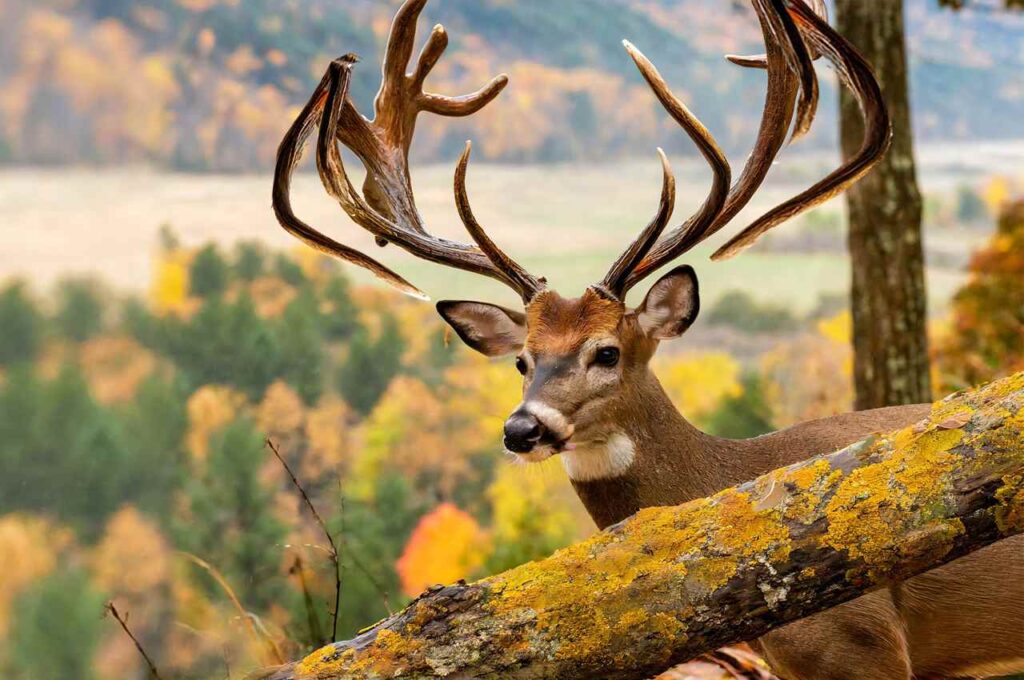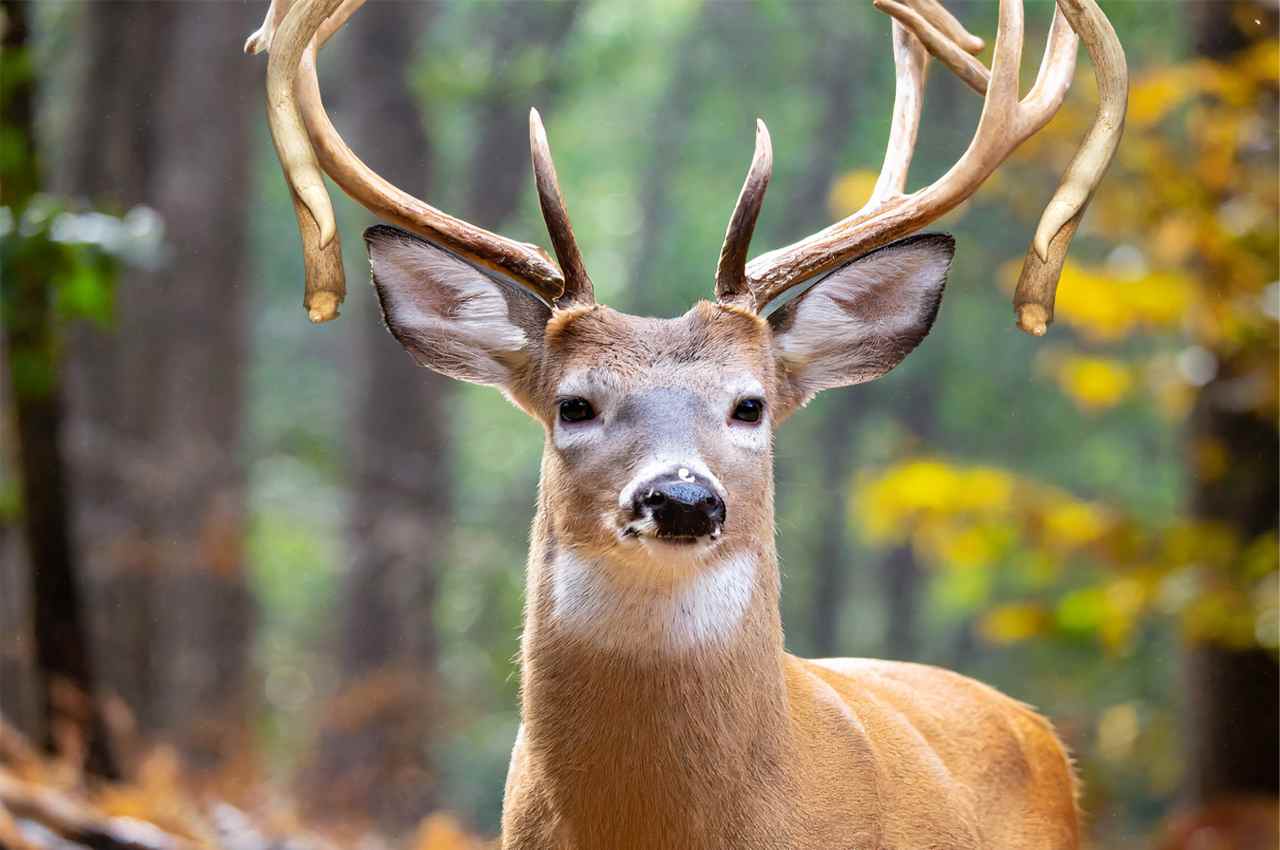What causes a drop tine on a deer seems to be related to the deer’s genetics and inheritance of specific traits. The mysterious drop tine on a deer’s antlers has captured the attention of both hunters and nature lovers. Many people are intrigued by this peculiar trait, where an antler tine develops downward instead of upward. We will go deeply into the realm of drop tines on deer in this comprehensive book, learning what they are, the causes of them, their importance to hunting and conservation, and much more.
Causes of a Drop Tine on a Deer
Genetics and environmental factors work together to convey why deer have drop tines.
- Genetics: Drop tines are assumed to form mostly as a result of genetics. Drop tines are more prevalent in certain deer populations, indicating that the characteristic may have a hereditary basis. Furthermore, the tendency of drop tines to run in families points to heritability.
- Environment: Drop tine development may also be influenced by the environment. For instance, deer living in locations with inadequate nutrition tend to have more drop tines. Thus, dietary stress may play a role in the development of drop tines.
Drop tine development may also be influenced by the following other factors:
- Injury: A drop tine may develop as a consequence of damage to the antler pedicle, which is the base of the antler.
- Disease: A few illnesses, such chronic wasting disease (CWD), may also result in drop tines.
- Hormones: Imbalances in hormone levels may cause the formation of drop tines and have an impact on antler development.
Not all deer with drop tines are ill, it is crucial to remember this. In actuality, a large number of deer with drop tines are healthy, thriving members of the herd. Drop tines, however, may be a symptom of underlying health issues, so it’s crucial to monitor deer with drop tines to make sure they’re in good condition.
Here are some additional facts about drop tines:
- Drop tines may be seen in various deer species, including mule deer and elk, although they are most often observed in white-tailed deer.
- Compared to younger bucks, elder bucks are more likely to have drop tines.
- Either one or both antlers may sprout drop tines.
- The size and form of drop tines might vary.
Deer antlers have something special and fascinating called drop tines. It is a genuinely unique experience to view a deer with drop tines, if you are fortunate enough to do so.

Occurrence of Drop Tines in Different Deer Species
| Deer Species | Occurrence of Drop Tines |
|---|---|
| White-Tailed Deer | Drop tines are rare, more prevalent in elderly whitetails, probably owing to their close taxonomic kinship with mule deer. |
| Mule Deer | Rare, mainly genetic in origin |
| Various Deer Species | Extremely rare |
Understanding Drop Tines
Defining Drop Tines
In the realm of deer antlers, drop tines are oddities that go against the usual development trend. Drop tines, which bend downward instead of upward as ordinary tines do, give deer a distinctive and memorable look.
| Characteristic | Description |
|---|---|
| Growth Direction | Downward |
| Appearance | Often thick, with black velvet |
| Rarity | Uncommon |
| Genetic Influence | Primary cause of occurrence |
The Allure of Drop Tines
What draws people to drop tines so much? Hunters and wildlife lovers are drawn to them because they are rare and have remarkable aesthetics, and they become almost fixated on seeing a buck with these beautiful antlers. The mystery behind drop tines’ occurrence adds to their fascination in addition to their attractive look.
- Their unusual antler structure distinguishes them.
- For hunters, rarity feeds their curiosity.
- The individuality of each drop tine adds to its attractiveness.
Importance of Understanding Drop Tines
In addition to being fascinating and intriguing, understanding the reasons for drop tines is essential for conservation efforts and appreciating the genetic variety of deer. Let’s explore the mystery behind these remarkable antlers and their effects on the deer population.
Features of the Drop Tine Deer
Understanding drop tines’ morphological characteristics, variations, and prominent instances in various deer species is crucial to appreciating them properly.
Physical Traits
Deer with drop tines differ from their counterparts with conventional antlers in a number of ways on the physical level. These traits may include huge, thicker antlers that often include black, stiffened velvet on the underside of the club-like tine. Because of this special mix, hunters prize drop tines as a trait.
| Trait | Description |
|---|---|
| Thicker Antlers | Often with a club-like tine |
| Velvet on Antler Bottom | Adds character to the antler |
| Eye-Catching Appearance | Draws attention of hunters |
Differences in Appearance
Drop tines differ from one another. Size, shape, and external appearance are all variable. Each deer’s antlers are a one-of-a-kind sight because to the wide variations in drop tine length and thickness.
- The drop tines’ size and shape vary.
- Each drop tine is an original piece of nature’s art.
- Captures the interest of nature enthusiasts.
Notable Drop Tine Bucks
Legendary drop tine bucks have made their mark throughout the history of deer hunting. We will explore the histories of these extraordinary animals and the hunters who hunted them. The individual histories of these deer contribute to the mystery around drop tines.
| Buck Name | Antler Description | Year of Capture |
|---|---|---|
| Morin Buck | Exceptionally developed brow tines | 1991 |
| Smith Buck | Long tines, numerous antler points | 1951 |
| Klinger Buck | Clustered antlers | 1976 |
In which deer species drop tines more common?
Mule deer sometimes have the distinctive trait known as drop tines, which is most often associated with whitetail deer. Examine the appearance of drop tines in several deer species and any changes that may be due to the species. Our understanding of these fascinating antlers is deepened by knowing which species have drop tines.
- Both mule deer and whitetail deer have drop tines.
- By species and geographic location, occurrence varies.
- Offers information on the genetic makeup of several deer species.
The Formation of Drop Tines
Now let’s focus on the elements that influence the development of drop tines in deer. Genetics, hormonal impacts, contextual circumstances, and dietary concerns are some of these elements.
Genetic Variables
Whether a deer will grow drop tines is mostly influenced by genetics. Learn about the genetic components of this phenomena and how certain genes affect the development of these distinctive antlers. Recognizing that not all deer possess the genetic material necessary for drop tines makes them an uncommon and treasured occurrence.
| Factor | Description |
|---|---|
| Hereditary Aspects | Specific genes influence it |
| Rare Occurrence | Not all deer carry these genes |
Hormonal Influences
Hormones have a significant role in antler development and may affect the growth of drop tines. Examine the role that hormonal changes may have in the development of these unique antlers. Drop tine formation is complicated further by hormonal factors, making it an exciting area of research.
- Hormones have an effect on antler development.
- Fluctuations may result in antlers that are unusual.
- Deepens our knowledge of the biology of deer.
Environmental Factors
The growth of a deer’s antlers, especially the development of drop tines, may be influenced by the environment in which it lives. Find out how the environment might affect the development of antlers. The environment greatly influences whether a deer’s antlers will grow into drop tines, from the availability of food sources to the temperature.
| Factor | Description |
|---|---|
| Food Availability | Nutrient-rich diets impact growth |
| Climate Conditions | Weather can influence antler size |
| Habitat Quality | Affects overall deer health |
Nutritional Considerations
The growth of a deer’s antlers is intimately related to its food. Examine how nutrition affects antler development and if certain dietary elements may result in the formation of drop tines. Hunting and conservationists may help deer populations by understanding the dietary factors that affect antler development.
- Nutrition affects the growth and form of antlers.
- Healthy antlers are a result of a balanced diet.
- Controlling food supplies is part of conservation measures.
The Rarity of Drop Tine Bucks
Appreciating drop tine bucks’ distinctiveness requires an understanding of their scarcity. Discover the facts about this deer, including their geographic range and occurrence rates.
Indicative Rarity
We’ll look at statistical data on drop tine bucks’ frequency in deer populations to get a better understanding of how uncommon they are. Although there may be variations in deer numbers, drop tines constantly remain an uncommon and valuable discovery.
| Rarity Level | Prevalence in Deer Population |
|---|---|
| Very Rare | Less than 1% of bucks exhibit drop tines |
| Rare | Occurs in approximately 1-2% of bucks |
| Uncommon | Found in about 3-5% of the buck population |
| Occasional | Occurs in 5-10% of bucks |
| Relatively Common | Found in 10-15% of bucks |
Geographic Distribution
Bucks with drop tines are not equally distributed around the world. We’ll look at the areas where these amazing species are most prevalent and unusual. Habitat and diet affect drop tine variance.
- The populations differ by area.
- Drop tine incidence is influenced by ideal environments.
- Regional variances are influenced by local circumstances.
Frequency of Sightings
How often do hunters and nature lovers encounter drop tine bucks? We’ll provide details on the frequency of sightings and the thrill that comes with them. Each glimpse of a drop tine is exciting and unforgettable because of its rarity.
| Sightings Frequency | Frequency of Hunter Encounters |
|---|---|
| Rare | Once in several hunting seasons |
| Occasional | Encountered every few seasons |
| Common | Regularly spotted each season |
| Very Common | Frequent sightings |
| Daily | Seen almost daily |
The Significance of Drop Tines
In the worlds of hunting and conservation, drop tines have a special position. They are important in terms of culture, science, and ethics; they are not merely interesting antlers.
Cultural and Traditional Perspectives
Drop tine bucks have historically been of particular importance in many different cultures and rituals. We’ll look at the cultural significance of these unusual deer. Drop tines have had a lasting impression on everything from current hunting culture to Native American legend.
- Myths and legends relating to drop tines in many cultures.
- Symbolism in native cultural traditions.
- Representations in literature and the arts.
Effects on Conservation and Hunting
Hunting methods and conservation initiatives may be affected by the existence of drop tine bucks. We’ll talk about how these deer affect deer population management and hunting tactics. Making better educated judgments on the management of wildlife is possible by understanding the effects of drop tines on hunting and conservation.
| Aspect of Impact | Influence on Hunting and Conservation |
|---|---|
| Hunting Strategies | Pursuit of drop tine bucks influences tactics |
| Management Decisions | Conservation efforts adapt to preserve unique genes |
| Trophy Hunting | Raises ethical and practical considerations |
Contributions to Scientific Research
Drop tine bucks provide important insights into the biology of deer for academics and researchers. We’ll look into how researching these special deer advances our knowledge of the whole species. Research on drop tines not only broadens our understanding of animal biology but also enriches our understanding of deer.
• Genetic research sheds light on deer genetics.
• Environmental and hormonal research promotes the biology of animals.
• Studying uncommon antler features is useful for conservation studies.
Conservation and Hunting
The ethicality of hunting drop tine bucks poses problems for conservation initiatives. Examine the morality of taking these special deer to preserve their DNA and hunting ethics.
| Ethical Aspect | Considerations |
|---|---|
| Selective Harvesting | Balanced hunting for genetics and population |
| Preservation of Genes | Ensuring unique genes remain in the population |
| Conservation Programs | Supported by ethical hunting practices |
Conservation initiatives
Drop tine deer are being protected and studied by conservationists. We’ll highlight the initiatives made to save these distinctive genomes in the wild. To protect the future of drop tine bucks, conservation initiatives are crucial, from habitat preservation to breeding programs.
| Conservation Measure | Actions to Preserve Drop Tine Genetics |
|---|---|
| Habitat Preservation | Protecting the natural environment |
| Captive Breeding Programs | Controlled breeding for genetic diversity |
| Wildlife Corridors | Facilitating deer movement and gene flow |
Frequently Asked Questions
What is a drop tine on a deer?
A drop tine on a deer refers to an antler tine that extends downward from the main antler beam by at least six inches, with the most desired having drops of seven to ten inches. Hunters covet these unusual qualities. Most drop tines are hereditary, however traumas around the antler base or abnormalities may induce them. Hunters appreciate non-typical deer like drop-tinned bucks because they are fully developed and healthy.
How do drop tines affect a deer's survival in the wild?
There is little evidence that drop tines affect deer survival in the wild. Genetics, trauma, and age may cause these odd antler traits. Drop tines are desired by hunters, but their impact on deer health and behavior in the wild is unknown. Thus, determining their impact on wild deer survival is difficult.
Is a drop tine genetic?
Yes, a drop tine on a deer is often genetic in nature. Both parents must contain the recessive gene to produce fawns with drop tines. While past injuries or age may cause drop tines, genetics are the major cause, and it becomes more likely as bucks mature. Drop tines are unusual in deer due to genetics.
Are drop tines good?
Personal judgment determines whether drop tines are “good” or not. Due to their rarity, hunters and collectors treasure these deer antler traits, although their attractiveness varies. Drop tines, a natural and distinctive feature of deer antlers, frequently come from genetic coding, indicate a buck is completely developed and healthy. Their worth depends on the person.
How rare are droptines?
Because drop tines are so uncommon, even seasoned hunters often claim to have never seen one. These distinctive antlers are mostly hereditary and grow more prevalent as bucks age. Hunters award drop tines as trophies because of their rarity. They indicate that a buck is completely developed and healthy, but not necessarily its health.
Can a deer grow a drop tine in one year?
Drop tines are uncommon to grow in one year in deer. A deer’s antlers, including drop tines, develop over many years, commencing in their first year. Drop tines are more abundant in older bulls, indicating they form throughout many years of antler development. Deer lose and regenerate their antlers throughout their lifetimes, growing new, uniquely-shaped ones swiftly in spring and summer.
Are drop tines considered desirable by hunters?
Yes, drop tines are highly desirable among hunters. Their unusual look, rarity, and position as a sign of fully developed and healthy bucks make them a prized trophy for hunters and collectors. Hunting enthusiasts value drop tines and non-typical deer.
Are drop tines more common in certain deer species?
Drop tines in deer are unusual and linked to heredity rather than species. While white-tailed and mule deer have different antler structures, drop tines are rare, making it hard to tell which species has them more.
Can a deer with a drop tine still breed?
Deer with drop tines may breed. Genetically generated drop tines on antlers do not influence a deer’s capacity to breed. In deer, antlers are mostly utilized for fighting and show during breeding season, not reproduction.
Do drop tines affect a deer's health or behavior?
Drop tines, a hereditary trait of antlers, generally do not affect deer health or behavior. Hunters value drop tines, although they don’t indicate a deer’s health or temperament. Antlers are mostly employed for fighting and breeding.
Are drop tines more common in older bucks than younger ones?
Drop tines are more prevalent in older bucks than younger ones. Abnormal points, particularly drop tines, increase with deer age, with few appearing in bucks under 2 years old. Drop tines are uncommon and distinctive to deer antlers, and genetics determine their presence.
Are there any plants or environmental factors that can cause a drop tine on a deer?
Drop tines are genetically predisposed and need good nourishment to attain their genetic potential. While damage may generate aberrant tines, it is unknown whether certain plants or environmental variables cause deer drop tines.
Conclusion
In conclusion, a combination of genetic and environmental variables contribute to the development of drop tines in deer. Nutrition, stress, and injury may all influence the formation of drop tines, although genetics play the major part.
Drop tines may be not be seen in various deer species, although they are usually observed in white-tailed deer and few in mule deer. They may develop on either or both antlers and are more prevalent in older bucks than in younger deer. Although drop tines may come in a variety of sizes and shapes, they are normally smaller than the antlers’ principal beams.
While most deer are unaffected by drop tines, sometimes they might be so enormous that they obstruct the deer’s mobility or eyesight. In certain situations, a vet may have to take out the drop tine.
Deer antlers have something special and fascinating called drop tines. It is a genuinely unique experience to view a deer with drop tines, if you are fortunate enough to do so.
- California Deer Hunting Guide: Seasons, Rules, Permits, and More - 26 June 2024
- Arkansas Deer Season 2024 [Schedules, Licenses, Bag Limits & More!] - 26 June 2024
- 2024 Arizona Deer Season New Dates & Rules! - 25 June 2024




